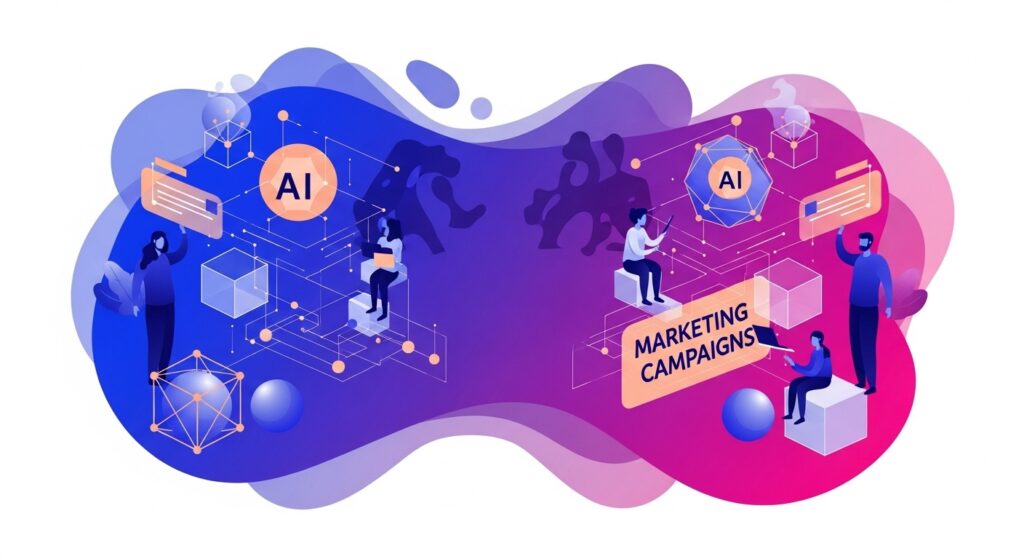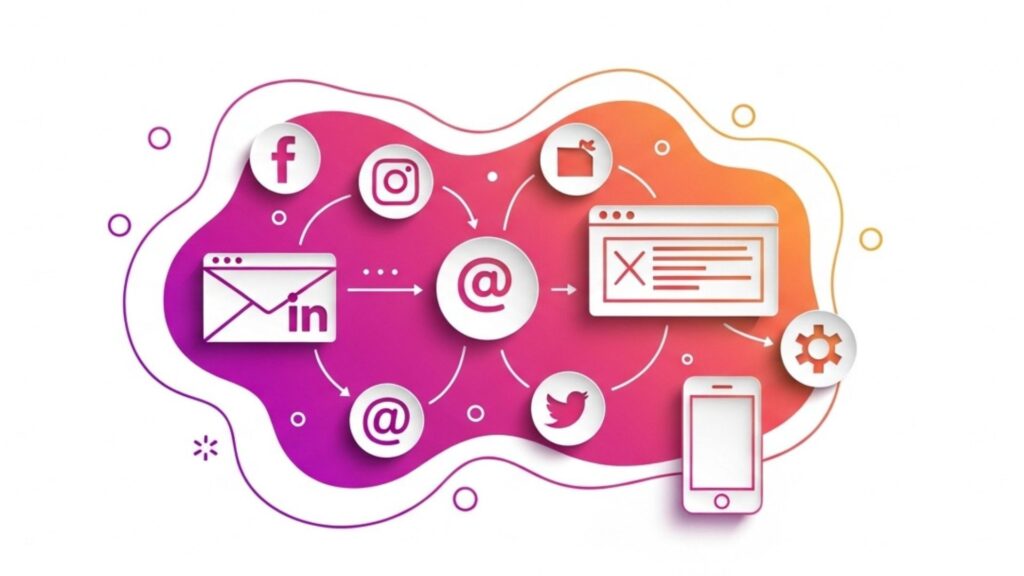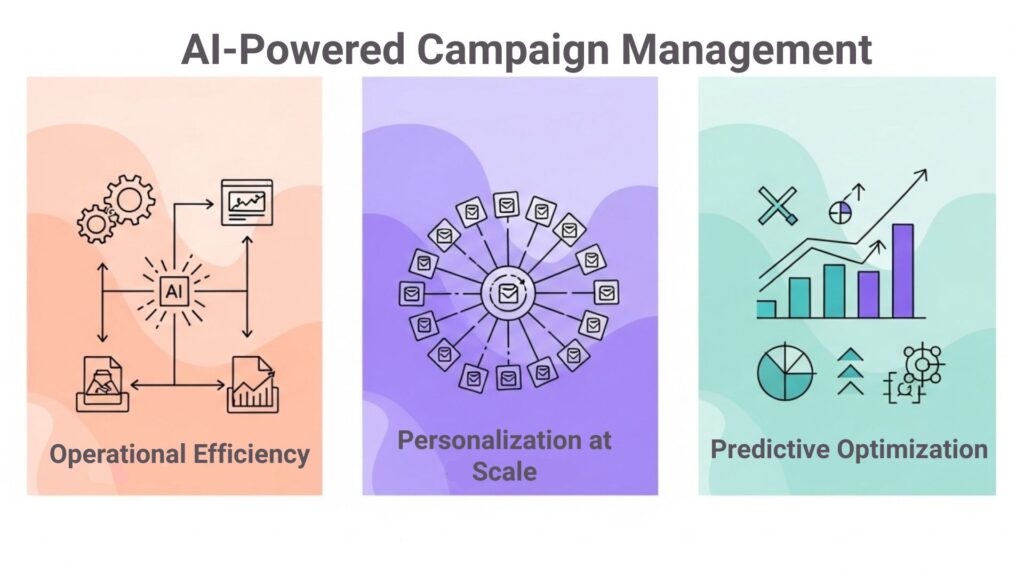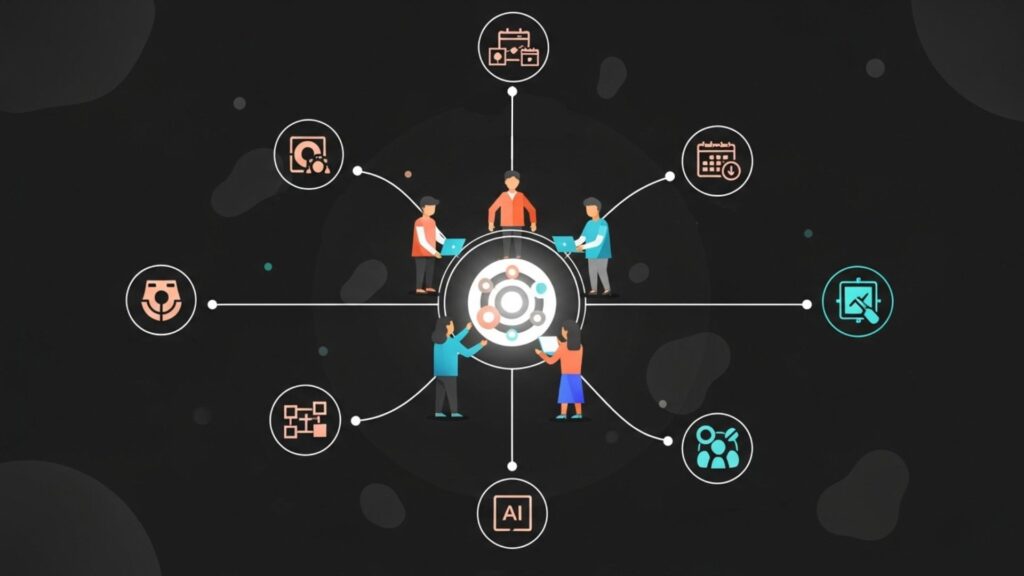AI-powered campaign management technology is revolutionizing how modern marketing teams operate and compete.
- Companies leveraging personalization drive more revenue than those who don’t, while modern automation saves marketing teams hours per week on manual tasks.
- Modern platforms integrate predictive analytics, autonomous optimization, and real-time personalization to create campaigns that adapt and improve continuously without human intervention.
- Organizations report dramatic operational improvements, including reduced campaign launch timelines, enhanced compliance accuracy, and measurable ROI gains across industries.
- Real-world implementations show transformative results with companies managing thousands of projects using fewer resources while achieving faster time-to-market.
The gap between early adopters and traditional approaches will only widen as AI capabilities advance.
Campaign management technology has come a long way from basic scheduling and email automation. Today’s marketing leaders are using artificial intelligence to create campaigns that actually think, adapt, and optimize themselves in real time. With 78% of businesses already using AI in at least one marketing function, intelligent campaign management isn’t just a nice-to-have anymore—it’s becoming essential to stay competitive.
The shift is dramatic. Companies using personalization drive 40% more revenue than those who don’t. Think about it: marketing teams used to spend days manually segmenting audiences and weeks testing campaign variations. Now AI can analyze millions of data points, predict customer behavior, and optimize messaging in milliseconds.
What is Campaign Management Technology?
Campaign management technology includes all the platforms, tools, and systems that help marketing teams plan, execute, track, and analyze campaigns across multiple channels. The most innovative solutions today feature AI-driven personalization engines, predictive analytics platforms, and autonomous optimization systems that can actually make decisions on their own.
Leading platforms integrate seamlessly with existing martech stacks, connecting content operations platforms, customer relationship management systems, and data analytics tools. These integrated environments let marketing teams orchestrate complex, multi-touchpoint campaigns that respond dynamically to customer behavior and market conditions.
The scope of campaign management technology includes sophisticated audience segmentation capabilities that use machine learning to identify prospects, content personalization engines that adapt messaging in real time, and performance optimization systems that continuously refine campaign elements based on emerging data patterns.
How is AI Revolutionizing Campaign Management?
Artificial intelligence is altering how marketing teams approach campaign creation, execution, and optimization. AI in campaign management operates across multiple dimensions, creating intelligent systems that enhance every aspect of campaign performance. Let’s explore how this is playing out across the industry.

Predictive Campaign Analytics
Modern AI algorithms analyze historical campaign performance, customer behavior patterns, and market conditions to forecast results before you even launch. Predictive analytics helps marketing teams figure out which audience segments are most likely to convert, which messages will resonate best, and which channels will deliver the strongest ROI.
Advanced predictive models can anticipate customer lifetime value, identify prospects at risk of churning, and recommend the best timing for campaign touchpoints. With this level of forecasting, marketing teams can allocate budgets more strategically and set realistic performance expectations based on data-driven insights rather than historical averages.
Autonomous Campaign Optimization
Agentic AI is the next frontier in campaign management technology, and it’s pretty remarkable. These intelligent systems make strategic decisions on their own—adjusting bidding strategies, reallocating budget across channels, and modifying audience targeting without anyone having to tell them what to do.
Autonomous optimization continuously monitors campaign performance metrics, comparing actual results against predicted outcomes and making real-time adjustments to improve effectiveness. Campaigns can adapt to changing market conditions, seasonal fluctuations, and emerging customer preferences faster than humanly possible.
Real-Time Content Personalization
AI-powered personalization engines analyze individual customer behavior, preferences, and context to deliver tailored content experiences across every touchpoint. Modern systems can adapt email subject lines, modify website content, and customize social media messaging based on individual user profiles and real-time behavioral signals.
Dynamic content optimization ensures that each customer interaction feels relevant and valuable, improving engagement rates and conversion performance. Advanced personalization platforms can even automatically generate new content variations, testing different approaches and optimizing for maximum impact.
Real-World Empowerment in AI-Powered Campaign Management
Organizations across industries are achieving remarkable results through intelligent campaign management. These success stories demonstrate the impact of AI-driven approaches on marketing performance and operational efficiency. Here’s what’s happening in the real world:

Publishing Industry Transformation
A leading book publishing company managing over 600,000 products was struggling with its outdated campaign management system. Manual asset distribution took hours, creating major bottlenecks for critical marketing campaigns around big releases.
The organization implemented an AI-powered content operations platform that automated asset distribution and campaign coordination across multiple retail channels. The transformation included intelligent metadata processing, automated workflow routing, and predictive content recommendations based on historical performance data.
The company successfully migrated its entire operation over a single weekend, with campaigns running seamlessly the following Monday. Tasks that previously required hours of manual work were completed automatically in approximately 20 minutes. The system now distributes thousands of book covers overnight to retail platforms without human intervention, while AI algorithms optimize placement and timing based on market conditions.
What’s even more impressive? The implementation required minimal training for over 800 users, demonstrating how intuitive modern campaign management technology has become. The organization discovered 779 duplicate copies of a single asset in their legacy system, highlighting the efficiency gains possible through intelligent automation.
Banking Industry Content Operations
A nationally chartered bank with over 300 branches was under mounting pressure to accelerate marketing campaign delivery while maintaining strict regulatory compliance. The organization had already experienced two failed technology implementations, leaving teams reliant on manual processes that couldn’t scale with growing campaign demands.
The bank’s marketing teams were managing campaigns using disparate systems, network drives, and individual computers, creating significant operational challenges. Audit requests that should have taken hours were consuming up to three weeks of team resources, while complex approval workflows created bottlenecks that delayed critical marketing initiatives.
The organization implemented an integrated content operations platform that automated workflow routing, centralized asset management, and streamlined compliance processes. The system created a single source of truth for all branded assets while enabling real-time collaboration between marketing teams, compliance officers, and external agencies.
The bank successfully managed 2,000 projects within two years using fewer resources than previously required. Automated workflow routing eliminated manual handoffs, generating productivity gains equivalent to 30% of a full-time employee. Audit response times dropped from three weeks to under 10 minutes, while 150+ active users across 40 lines of business adopted the platform for unified campaign management.
What Features Define Modern Marketing Tools?
Today’s campaign management technology looks vastly different than traditional marketing automation platforms. Modern marketing tools integrate advanced AI capabilities with user-friendly interfaces and comprehensive analytics to create powerful yet accessible campaign management environments. Here’s what sets them apart:

Intelligent Asset Management
Advanced platforms incorporate AI-powered digital asset management that automatically categorizes, tags, and optimizes content for different campaign uses. Computer vision technology analyzes visual assets to understand composition, color schemes, and subject matter, while natural language processing examines text-based content for tone, sentiment, and compliance factors.
These intelligent systems recommend the most appropriate assets for specific campaigns, audiences, and channels. Machine learning algorithms identify which content types perform best in different contexts, helping marketing teams make more informed creative decisions while reducing time spent searching for materials.
Agentic Campaign Orchestration
The most advanced modern marketing tools incorporate agentic AI capabilities that can autonomously plan and execute multi-step campaigns. These systems understand campaign objectives, analyze available resources, and create comprehensive execution plans without requiring detailed human instruction.
Agentic platforms can coordinate complex campaign sequences across multiple channels, adjusting timing and messaging based on customer responses and external factors. In turn, marketing teams can focus on strategy and creativity while ensuring consistent execution at scale.
Cross-Channel Performance Analytics
Modern tools provide comprehensive analytics that track campaign performance across all digital and traditional channels. Advanced attribution modeling helps marketing teams understand the complete customer journey—which touchpoints actually move people toward conversion and which ones don’t.
Real-time analytics enable immediate campaign adjustments, while predictive modeling forecasts future performance based on current trends. These insights help marketing teams continuously optimize budget allocation and refine targeting strategies.
How Should Organizations Implement Campaign Management Technology?
Enhancing how you manage campaigns with new tech requires careful planning, phased deployment, and strategic integration with existing marketing operations. Organizations that approach implementation systematically achieve better results and faster time to value. Here’s how to get it right:
Technology Infrastructure Assessment
Before implementing new campaign management tech, take stock of your current technology stack and data infrastructure. Modern AI-powered platforms need solid data integration to access customer information, campaign performance metrics, and external market data.
Cloud-based platforms typically offer easier integration paths and more flexible scaling options compared to on-premises solutions. Prioritize platforms that provide comprehensive API access and support for real-time data synchronization across multiple systems.
Phased Implementation Strategy
The most successful implementations follow a phased approach that builds capabilities gradually rather than attempting comprehensive transformation all at once. Begin with specific use cases that offer clear ROI potential, such as email personalization or social media automation.
Starting with content management workflows often provides the best foundation for broader AI implementation. These areas typically offer immediate productivity gains while establishing the data quality and process frameworks necessary for more advanced AI capabilities.
Team Development and Training
AI-powered campaign management technology changes how marketing teams work**, requiring** new skills in data analysis, AI tool management, and performance optimization. Invest in training programs that help team members understand what AI can and can’t do, while building workflows that let humans and intelligent systems work together effectively.
Cross-functional collaboration becomes increasingly important as AI systems integrate marketing, sales, customer service, and analytics functions. Teams need clear guidelines for managing AI-generated content, interpreting algorithmic recommendations, and maintaining brand consistency across automated campaigns.
What Are the Key Benefits of AI-Powered Campaign Management?
Organizations following intelligent campaign management report measurable improvements across multiple performance indicators. The results speak for themselves:

Operational Efficiency Improvements
AI automation eliminates time-consuming manual tasks that consume significant resources, with marketing teams saving an average of 25 hours per week through intelligent automation. Automated asset tagging, audience segmentation, and performance reporting free up marketing teams to focus on strategy and creative development.
Advanced platforms reduce campaign launch timelines from weeks to days while improving consistency and accuracy. Automated compliance checking ensures campaigns meet regulatory requirements without manual review, a game-changer in regulated industries like financial services and healthcare.
Enhanced Personalization at Scale
Modern campaign management technology enables personalization capabilities that were previously impossible at enterprise scale. AI algorithms can create thousands of content variations, simultaneously test multiple approaches, and optimize messaging for individual customer preferences.
Dynamic personalization includes real-time behavioral analysis, contextual awareness, and predictive intent modeling. This sophisticated approach to personalization improves customer engagement and conversion rates while reducing marketing waste.
Predictive Performance Optimization
AI-powered platforms provide predictive insights that help marketing teams optimize campaign performance before issues become apparent in traditional metrics. Early warning systems identify campaigns that may underperform, enabling proactive adjustments that prevent wasted spending.
Predictive analytics also improves budget allocation decisions by forecasting which channels and audiences will deliver the best returns. This capability enables more strategic resource allocation and better overall campaign ROI.
Frequently Asked Questions
What makes AI-powered campaign management technology different from traditional marketing automation?
AI-powered systems can make strategic decisions independently, learn from campaign performance, and adapt to changing conditions without human intervention. Traditional automation follows predetermined rules, whereas AI systems continuously analyze data patterns and optimize performance.
How quickly can organizations see results from implementing modern campaign management technology?
Organizations typically see immediate improvements in operational efficiency, with more significant performance gains becoming apparent as AI systems learn from campaign data and optimization algorithms mature over time.
What level of technical expertise is required to manage AI-powered campaign tools?
Modern platforms are designed for marketing professionals rather than technical specialists. While some data literacy is helpful, most systems provide intuitive interfaces and automated setup processes that require minimal technical expertise.
How do AI systems ensure campaign compliance and brand consistency?
Advanced platforms include built-in compliance checking, brand guideline enforcement, and automated content review workflows. AI algorithms can detect potential issues and route content for human review when necessary.
What data requirements are necessary for effective AI campaign management?
Organizations need clean customer data, historical campaign performance metrics, and consistent content tagging to maximize AI effectiveness. Most platforms provide data quality assessment tools to help organizations prepare their information for AI analysis.
Harness the Full Potential of AI-Powered Campaign Management
The transformation of campaign management through artificial intelligence completely shifts how marketing teams operate and compete. As these technologies continue advancing, the gap between early adopters and traditional approaches will only widen.
Organizations need platforms that combine intelligent automation with enterprise-grade capabilities and intuitive user experiences. Aprimo’s content operations platform delivers the integrated AI capabilities, workflow automation, and performance analytics that modern marketing teams need to thrive. Discover how Aprimo can transform your campaign management capabilities and drive measurable business results.


